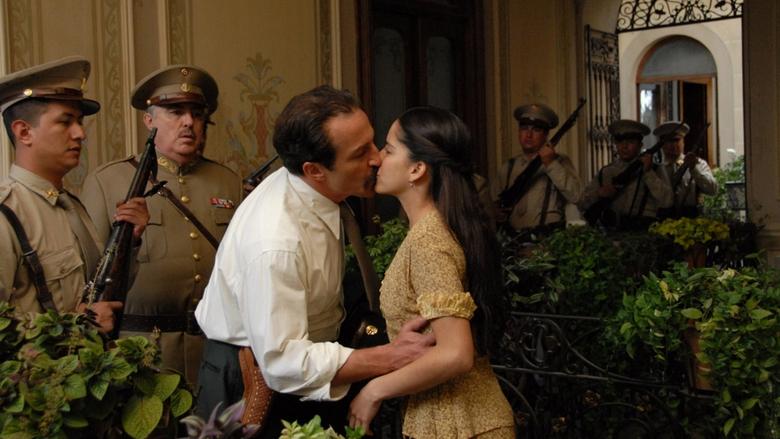

Tear This Heart Out (2008)
A young girl recounts her girlhood and eventual marriage to a general of the Mexican revolution. by one of the most outstanding writers of the new feminist Mexican literature, it is at once a haunting novel of one woman's life and a powerful account of post-revolutionary Mexico from a female perspective.
Watch Trailer
Cast


Reviews
In my opinion this is by far the best and most important Mexican movie since "La Sombra del Caudillo". A movie also made from a novel in 1960 that was seized by the army and never released, and was done in the same style of using fictitious names. After I heard that this movie was filmed in my home town Puebla (I'm a US citizen now living in LA), and a candidate for a nomination for best foreign film, I rushed for the book and read it. It didn't take too long for me to realize who and what she (Angeles Mastretta) was talking about, and I loved it. So I rushed for the DVD and couldn't find it, but somehow I saw the movie. In the version that I saw, I noticed an important and brief episode from the book (among others) that was missing in the movie almost at the end. I'm referring to a serenade performed by the best and most popular artists in those days, Pedro Vargas and Agustin Lara (there's a statue of Lara in a park in Los Angeles), that ended in a clean fist fight won by the kid with the motorcycle, that the young daughter of the general loved, and who mysteriously died a few days later in a motorcycle accident (?). Who was the rich kid? Well, who could afford to take these artists to Puebla for a simple serenade? But who wants to be an enemy of the media anyway. I wonder if the richest man in the world, whose name appears at the end in the credits as contributor to the movie, also contributed to the omission of this episode or if it was not filmed at all, that, I don't know. But anyway that is not too important compared to another character that is almost invisible in the book (and movie) by the name of "Don Mike Heiss". If you find out who he really was then do a simple research, like I did, and visit the archives of the New York Times. You'll be surprise of these articles from 1917 (the year Zapata was murdered)-1919 (Villa was murdered a few years later) when USA was about to invade Mexico again just to liberate this special agent ("Heiss") from a Puebla penitentiary. "HEISS" became the richest man in Mexico and probably in the world after Rockefeller, and was the partner of all the richest man in Mexico at the time, with the help of "General Ascencio", who was in charge of making offers nobody could refuse. After "Ascencio" died, "Cienfuegos" became one of the richest men in the world during the six years he was president. All this just proves that unfortunately there is nothing to celebrate next year on the centennial of the revolution the 18th day of November 1910, with the exception of remembering Aquiles Serdan the first martyr of the unconsummated and so-called revolution, initiated also in my beautiful home town of Puebla de Los Angeles (Mastretta?). The acting in this movie is the best I've seen in many years. Thank you Ana Claudia, Daniel and Roberto, from now on you are my favorite actors and director. Please don't go to Hollywood, you all are more needed in Mexico.
Period pieces in Mexico have been well done almost always, but productions of period pieces had been only made for soap operas, never before had a movie production been so well done.Although I never read the novel by Angeles Mastretta, I knew it was somehow accurate, since I hear she is a direct descendant from the story's protagonist Catalina -names are changed in the novel and film. This is shown by the richness of dialogs and curious anecdotes which constantly make you wonder which parts were completely true and which sprung from the author's vivid imagination.Apart from the richness from the story and how the storytelling evolves smoothly throughout the film, the production design makes you feel completely Mexico in the 1930s. The costumes are great also.The direction is almost perfect. Roberto Sneider takes you by surprise first at about minute 20, then slowly and smoothly hypnotizes you and never lets go.Much credit goes to the lead Ana Claudia Talancon whose good looks and very well developed character arc make you fall at first for her beauty and innocence, and later for her humanity, courage and cleverness.Daniel Gimenez Chaco's performance deserves praise also. He captures the Mexican Macho Persona perfectly, his cynical viewpoint of things and comments, bring humor to a character who would be otherwise despicable.Second characters like de Tavira's and others feel a bit underdeveloped, but in the end all actors do great jobs with their little screen time and their contribution suffice.The drama never falls for the temptation to go overly melodramatic and dialogs are kept smart enough - even ironic at times - to make this movie a fresh and satisfying take on the Mexican way of life. It actually feels so accurate that deep thoughts of "nothing has ever changed really" do spring a few times.The music and editing are very well done also.Congratulations to everybody involved!
I read Angeles Mastreta's book when it first came out and I just loved it. She's written some more afterwards, but I never really liked them as I enjoyed "Arrancame la vida". When I knew that a movie about this story was going to be done I read the book again, and to be honest I went to see the movie with the intention of reinforce that "stories are always better read in books, than depicted in movies". Well I was wrong. To my agreeable surprise I enjoyed every minute of it, just as much as I did reading the book for the first time. You easily digest a witty yet sarcastic story, picturing a post revolutionary country society that grabs you from the very first second. All the charactersare very well pictured and the scenery is just perfect. Thank you for this kind of Mexican cinema: enjoyable, brilliant and proudly capable of the quality to be appreciated by any kind of audience of the world.
Mexican director Roberto Sneider wrote the script of "Tear This Heart Out" ("Arráncame la Vida") with the author and winner of the Mazatlán Prize for Literature for the best book of the year Ángeles Mastretta published in Mexico in 1985 partially inspired by the life of Maximino Ávila Camacho, a four-star general in Mexico's revolutionary forces, brother of Manuel Ávila Camacho who was President of Mexico from 1940 to 1946...The film opens with the beautiful Catalina Guzmán (Ana Claudia Talancón) marrying at her early age a charismatic and cunning general named Andrés Ascencio (Daniel Giménez Cacho), much older than her Dazzled by his world, Catalina escorts him on his political campaigns, perceiving at his side the intriguing political systems to obtain social justice... Catalina, a smart but not an educated young woman, dedicates years of her youth to a 'loving' husband She comes to Puebla to hear from the voice of her man, the governor of the beautiful city, that soon she will be the First Lady of Mexico as he considers himself the best-qualified candidate to win the race for the Presidency... But one day, Catalina finds out that her arrogant and prepotent macho man is cheating on her with several women and has several children out of that relationship But in spite of all that, and observing her husband's pervert and bad manners, Catalina continues to live with Andrés, to bear his two children, to train his others children in her family, to serve him as his adviser and to guide him to win elections, taking intense pleasure from that attitude Nevertheless she learns that life and power are not always so pink There is a scene during her pregnancy, where we saw her detecting that she is totally neglected So, for the first time we watch her taking pleasure in having a love affair with a teenager who cherished her dearly But the movie takes a dramatic turn when Catalina falls really in love with a concertmaster... And it was forbidden for her to fall in love! And she executes her cruel vengeance on Andrés sharing the musician' bed ignoring the predestined course of his future fate And here Roberto Sneider's motion picture clearly comes off with three significant national old traditions: the 1930's post-revolutionary Mexico, the very crucial point for the Mexican girl, the "rite of passage," and the traditional macho man The film is a love story through which three main characters are important for the viewer: Andrés, the charming officer, the great orator with the voice so thrilling and so impacting His wife Catalina divulging how meaningless and insincere his promises are And Carlos (Jose María de Tavira), the leader of the orchestra, the future of a new Mexico, the rebel, and what Mexico is expecting from her younger men The motion picture presents the concept of the long-suffering Mexican woman vanishing here with Catalina as seen powerful of character, efficacious and extreme in having an affair with the man she deeply falls in love, intense in degree to accept whatever she is asked from her lover to carry out Her representation of the submissive wife, in a macho world where women are suppressed and their voices not heard, has fallen with her determined and ambivalent character here, as near Carlos, Catalina is another woman who wishes, requests, and desires intensely the enjoyment of her personal liberty and personal efficacy The result is a fine rich movie with many captivating visuals of the stunning state of Puebla, and definitely a must-see, at least for the Mexican viewers




